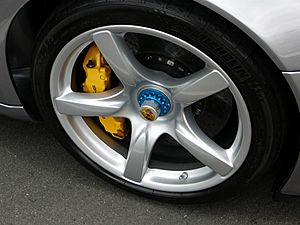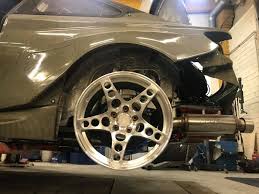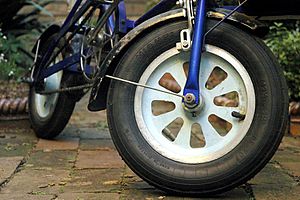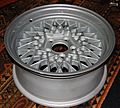Alloy wheel facts for kids
Alloy wheels are special wheels for cars that are made from a mix of metals, usually aluminium or magnesium. This mix is called an alloy. Alloys are generally stronger than pure metals, which can be quite soft. Wheels made from aluminium or magnesium alloys are often lighter than regular steel wheels. They also help cool the brakes better and usually look much nicer. Even though steel is also an alloy (a mix of iron and carbon), when people say "alloy wheel," they usually mean wheels made from these lighter, non-steel metals.
The very first light-alloy wheels were made from magnesium. They were popular in racing cars but not common on everyday vehicles. By the mid-1960s, new ways of shaping aluminium made it possible to create safer aluminium wheels that weren't as brittle. Before this, many early aluminium wheels could easily break. Once these better ways of making aluminium wheels became common, aluminium wheels took over from magnesium for both racing and regular cars because they were cheaper and performed well.
Contents
Why Alloy Wheels Are Great
Better Performance
Lighter wheels can make a car handle better. This is because they reduce something called "unsprung mass." This means the car's suspension can follow the road more closely, giving you better grip. Also, a lighter car uses less fuel. However, not all alloy wheels are lighter than steel ones.
Cooler Brakes
Alloy wheels are good at letting heat escape from the brakes. This is important because brakes can get very hot, especially when you're driving fast or stopping a lot. Keeping the brakes cool helps them work better and reduces the chance of them failing due to overheating.
Awesome Looks
Many people buy alloy wheels just because they look cool! Alloys can be polished to a shiny metal finish. However, these finishes need to be protected with paint or special coatings to stop them from getting rusty. Even with protection, they might start to corrode after 3 to 5 years. Luckily, you can often get them fixed up. The way alloy wheels are made also allows for many cool and detailed designs. Steel wheels, on the other hand, are usually pressed into shape and welded, which doesn't look as nice. They also need to be painted to prevent rust or covered with wheel covers.
Things to Consider
Alloy wheels can sometimes cause tires to lose air if they corrode where the tire meets the wheel. They are also harder to fix than steel wheels if they get bent. But because they cost more, repairing them is usually cheaper than buying a brand new one.
Alloy wheels are more expensive to make than steel wheels. So, they are often an extra option when you buy a car, or they come with more expensive car models. However, they have become much more common since the year 2000. Now, you can even find them on smaller, more affordable cars. Because alloy wheels are valuable, thieves sometimes try to steal them. To stop this, car makers often use special lug nuts that need a unique key to remove.
Most alloy wheels are made by casting molten metal into a mold. But some are forged. Forged wheels are usually lighter and stronger, but they cost a lot more. Some forged wheels are made in one piece, while others are made from two or three parts bolted together.
Aftermarket Wheels
Many car owners like to buy different alloy wheels for their cars after they've bought them. These are called "aftermarket" wheels. People choose them to make their car lighter, look more unique, or just to have bigger wheels. You can find wheels ranging from 14 inches all the way up to 30 inches!
Some aftermarket wheels even have "spinners" that keep turning after the car stops. While replacing steel wheels with lighter alloy wheels can make a car perform better, going for very large wheels doesn't always help. Tests have shown that very big wheels can actually make a car accelerate slower and use more fuel. They can also make the ride less comfortable and noisier.
Magnesium Alloy Wheels
The Original "Mag Wheels"
Magnesium alloy wheels were some of the first wheels made by pouring molten metal into a mold. They were often simply called "mag wheels." Magnesium wheels were first used for racing cars. Their popularity in the 1960s led to the creation of other cast wheels, especially those made from aluminium. The name "mag wheels" then became a general term for any cast wheels, even those made from aluminium or plastic.
Modern Magnesium Wheels
Pure magnesium wheels are not made anymore, you'll only find them on classic cars. Old magnesium rims could easily get pitted, cracked, and corroded. While it's hard to set fire to a big piece of magnesium, pure magnesium wheels could catch fire if a tire was burning or if the wheel scraped on the road for a long time after a flat tire.
However, modern alloys of magnesium were created to fix most of these problems. In fact, the US Federal Aviation Administration (FAA) has done many tests and now believes that the risk of magnesium catching fire is no longer a concern. New ways of treating the surface of magnesium wheels protect them from corrosion and make them last much longer.
How Alloy Wheels Are Made
Forging
Forging is a process where metal is shaped by heating it and then applying very high pressure, often by hammering or rolling. This changes the metal's structure, making the wheels much stronger and lighter. Forged wheels are usually tougher and more flexible than cast aluminium wheels, but they cost a lot more to make.
Assembly
Forged wheels can be made in one piece, or they can be made from two or three separate parts that are then bolted together. Each part starts as a solid block of alloy metal.
High Pressure Die Casting
In this method, molten magnesium is quickly pushed into a mold (called a die) using high speed and pressure. The metal cools and hardens, and then the wheel is released. Wheels made this way are cheaper and resist corrosion better. However, they are not as strong or flexible as forged wheels.
Low Pressure Die Casting
This process uses a steel mold placed above a pot of molten magnesium. Air pressure is used to push the molten metal up into the mold. When done correctly, low pressure die casting can make wheels that are more flexible than other cast wheels, but still not as flexible as forged magnesium wheels.
Gravity Casting
Gravity-cast magnesium wheels have been made since the 1920s. They are quite flexible and have good properties, often better than what can be achieved with aluminium casting. The tools needed for gravity casting are among the cheapest to make. This allows for small batches of wheels to be produced, offering more design choices and faster development times.
See Also
 In Spanish: Llanta de aleación para niños
In Spanish: Llanta de aleación para niños
- Cast alloy wheels
Images for kids
-
A Chrysler alloy wheel.








